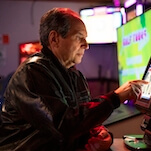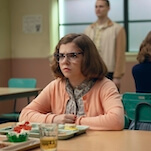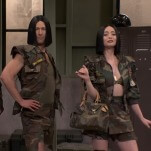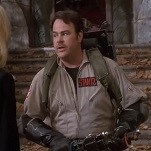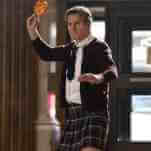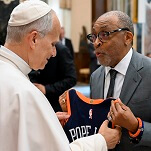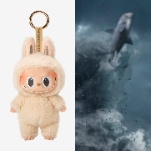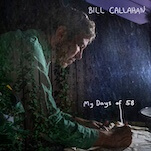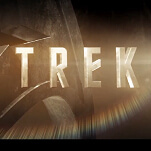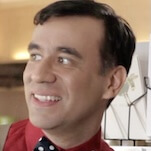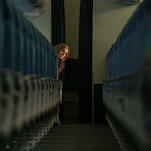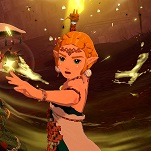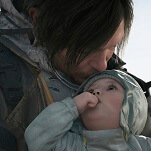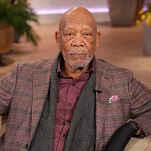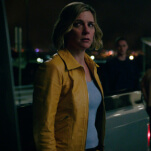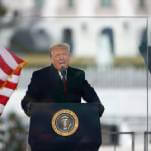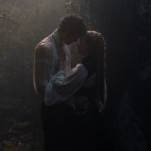Despite not being much more than a face, Kirby has never been the face of Nintendo. He’s never as striking as Samus Aran, never the icon like Link, never a revolutionary like Donkey Kong or Mario. He’s a pleasant puffball whose only defining personality traits are his even temper, gluttonous appetite, and a penchant for wacky hats. Old Kirb was never even supposed to exist. Creator Masahiro Sakurai made him a stand-in sketch, a placeholder while designing a game that was to be replaced later by someone more appealing.
Kirby’s nature as a blank slate is his essence as a character, though. He’s malleable, squishy, and moldable, a character that’s both lovable and deeply functional. Sakurai’s pink puff slots logically into almost any role, whether it’s deeply traditional or playfully experimental, making him a perfect icon for Nintendo. The company’s built an empire on indulging its oddest and safest impulses simultaneously. Kirby isn’t the face of Nintendo. He’s not Mario or Pikachu, but his 22-year career embodies Nintendo’s appealing creative spirit, vacillating between staid routine and weird experimentation.
Kirby’s Adventure, 1993
As with many of Nintendo’s best ideas, Kirby congealed over a few games. Kirby’s Dreamland for the original Game Boy hit in 1992, and while Kirby could do some of his standard moves, there wasn’t much else to his debut. He could fly by inflating his body and swallow enemies, but that was about it. The whole debut takes just about a half an hour to complete. Like Super Mario Bros., it felt like a rough draft. “Mario can jump! And he hates turtles, especially turtles that live in giant castles surrounded by pipes. It’s cool, though, because he can use those pipes to go secret places so he can… rescue a princess? I guess?” It took jumping to the NES to firm up what Kirby was capable of.
Kirby’s Adventure borrows and expands Dreamland’s
core, inflating its appealing weirdness. Walk through a series of stages from left to right; fight big bosses like a giant tree with deadly breath who needs to be hit in the face with his own apples; keep doing it until there are no more levels to walk through. Adventure had roughly 10 times the number of stages, though, and filled them with secret exits and alternate routes. Kirby himself changed dramatically. Rather than just swallowing bad guys, he’d take on enemy abilities, like a gustatory Mega Man. Eat a sentient tire, and Kirby turns into a speedy roadster. Eat a googly-eyed fireball, and Kirby breathes fire. (Later games had Kirby don specific hats for each power, which helped keep clear what you could do and looked cute as hell.) As Super Mario Bros. 3 did for Super Mario Bros., Adventure filled Kirby’s life with new color and tricks, creating a jumping off point for further experimentation.
Kirby Super Star, 1996
Nintendo’s willingness to indulge its weirdest creative whims is part of what made it such a beloved institution. (Hence why its general stodginess in recent years has been so disappointing.) Mario and friends? Throw them in some go karts! That Wario dude with the mustache? Let’s make a scatological, schizophrenic collection of comedy games about him and pair him up with a dog mechanic and disco stud! Kirby Super Star on Super Nintendo packaged that philosophy in one little grey brick, and it still felt familiar as a Kirby game on top.
Super Star jumps all over the place. It’s an episodic tale about Kirby duking it out with his usual antagonists, like obese penguin despot King Dedede and rival/twin Meta Knight, as well as newcomers like a giant bird with metal wings named Dyna Blade. The adventure is broken into eight small games, though. One second Kirby will be jumping across clouds and eating enemies, like he did in Adventure, and the next he’ll be in a one-on-one race with Dedede where Kirby’s speed is dictated by how much fruit he runs into. After that, it’s The Great Cave Offensive, where he hunts odd treasures in an interconnected cave system. Or it’s The Arena, fighting through a gladiatorial endurance trial.
Super Star is no more conceptually strange than previous Kirby games. “Try to eat eggs, not bombs!” is something Kirby’s Adventure actually asks you to do at one point. But the constant shifts between different activities are brand new. What’s more, all those shifts are grounded and approachable thanks to Kirby himself. The little pink dude is always there, so learning how to play something different doesn’t feel quite so intimidating. It’s the same philosophy that lowers the barrier of entry to oddities like Mario Hoops 3-On-3—what with its basketball-playing ninjas—Metroid Prime Pinball, and Pokémon Snap. A game about photography doesn’t seem so bizarre and unapproachable if it’s about snapping pics of familiar fantasy critters.
Kirby’s Dream Course, Canvas Curse, etc.
In the decades since Kirby Super Star, Kirb’s flights of fancy have been more spread out than they were in that package, but even more far ranging in their conceptual flexibility. Released within a year of Super Star, Kirby’s Dream Course, for example, casts Kirby as a would-be golf ball that players try to sink into strategically placed holes in chunks of abstract geometry. The whole thing looked like a ’90s pop-art nightmare.
As the years went on, some of Kirby’s wild adaptability faded away. Racing game offshoots like Kirby’s Air Ride felt as safe and familiar as the original Kirby’s Dream Land, and the successive platforming games in that original vein proved enjoyable but not exactly brimming with imagination. That too recalls Nintendo’s habit of falling into comfortable routines. Like The Legend Of Zelda groove Nintendo settled into after A Link To The Past where it simply riffed on a proven formula, Kirby mostly appeared in variations of the Adventure/Dreamland style.
But like Nintendo’s fits of inspiration that birth games like Tomodachi Life, Kirby could still turn in a curveball. Kirby Canvas Curse provided the Nintendo DS with its first essential title in 2005. A touch screen-controlled game turned in years before they were literally a dime a dozen on the iPhone, Canvas Curse retained the platforming and power stealing of old Kirby games but took away the familiarity of buttons. Touching the screen produces rainbows for Kirby to slide around on, like a roller coaster of light. It felt like nothing else and was initially difficult to manage, but Kirby was still there, still turning into a wheel to go fast or eating a spark to get electric powers. Something odd and funny paired with something instantly knowable—a familiar face; Nintendo at its best.

